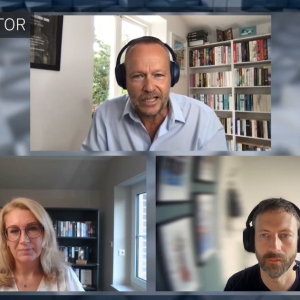Informix Software Inc is about to get itself a desktop partner a la Sybase Inc’s Powersoft Corp in the shape of Visual Basic house CenterView Software Inc: at least that is how CenterView would like to view the arrangement. Informix is not arguing with that interpretation although it is not actually buying the San Francisco, California-based company. It will bundle CenterView’s new Data Neighborhood Windows- and Web browser-to-relational database communications architecture with its future Universal Server Windows NT combination of Informix Dynamic Scalable Architecture database and the Illustra Technologies server later this year. In fact CenterView has grandiose plans to make the Neighborhood – a name borrowed from Windows95’s Network Neighborhood – ubiquitous by giving the thing away if it needs to, but Informix is its first significant endorsement. CenterView is aiming to sell its Data Director 2.0 Visual Basic application development environment (formerly Choreo) and Active S QL data access control for ActiveX plus future development tools on top of Data Neighborhood wherever it is in use. Java and Unix Other Visual Basic tools can plug into Data Neighborhood too, the idea being they will all use the CenterView technology to deploy Web and client-server applications over intranets and pay something along the way. CenterView is already planning a U nix version of the development tools for Informix and is talking to Sun Microsystems Inc about other Java and Unix work. CenterView touts Data Neighborhood as a means for corporate intranet users to access all of their relational database resources from Visual Basic without developers or users having to become intimately familiar with every database they access. CenterView has created a Data Source Transfer Protocol to run over HyperText Transfer Protocol which it claims provides full support for executing SQL commands from a browser’s Internet Universal Resource Locator finder, retrieving database results into HyperText Mark-up Language and maintaining database c onnections. It supports ActiveX, Java and Object DataBase Connectivity data base communication and CenterView says it’s currently hustling up the kind of industry support that would make it a credible protocol to take to the World Wide Web Consortium. The server piece, for which there will be an unspecified charge that Cent erView describes as a tax on the driver vendors who will use it to connect their speciality data stores, runs Windows NT versions of Microsoft Internet Information Server or Netscape Communications Corp Server. The Data Neighborhood client includes an Object DataBase Connectivity driver which is installed dynamically whenever an ActiveX or Java application is accessed from Windows or browsers. Applications can be accessed through a Universal Resource Locator address, the Object Data Base Conne ctivity driver or a Data Director Object programming interface. There’s no development charge and deployment will cost $5 to $40 depending on volume. By William Fellows CenterView is seeking bundling deals for Data Neighborhood and the other products. Its existing Choreo partner, LogicWorks Inc, has already committed to selling a new Web-enabled Choreo 2.0 release – now renamed Data Director – from this month. Log icworks claims to have 45% of the Object Linking & Embedding data modelling market, has 60 salespeople on it and aims to sell 22,000 licences over two years. CenterView has integrated TV Object Inc’s VBnet software for converting Visual Basic forms into HyperText Mark-up Language with Director, which it claims is effectively a Visual Basic development extension. What Director is claimed to do well is link groupware or shared client-server applications through its repository, making it a low-en d Forte Software Inc if you like. CenterView will go the distributed object route – Network Object Linking & Embedding and Corba – in future. The $1,300 Data Director is a C++-based data access engine built around an object repository and data model ler. CenterView will recode the thing in Java later this year. Developers will use ActiveX to bring to Java applications the same kind of visualisation currently created with Visual Basic. The $200 ActiveSQL, described as a data control language for ActiveX, enables developers to embed database access into any HyperText Mark-up Language page and display data in grids, lists or text fields or in any other data-bound ActiveX control. CenterView claims this avoids the need to maintain Common Gate way Interface and server-based templates. Data from multiple databases can be accessed in the same page. It requires an ActiveX plug-in for Navigator to run. Although CenterView will build on its installed base of just 2,000, as well as Logicworks’s channels, its intent is to ride its Visual Basic credentials in the Microsoft Corp space and wherever Data Neighborhood gets deployed. Its aim is to capture 60% of the browser market for the database access protocol. Its Unix obstacle isn’t technol ogy but the channels, controlled by the server vendors. CenterView will support the Java DataBase Connectivity application programming interface by plugging its Data Source Transfer Protocol into the placeholder JavaSoft has left in the application programming interface to enable third party protocol connections. Data Director is out this month; ActiveSQL ships later in the third quarter; Data Neighborhood goes into beta test this month and goes gold in September. Other Web-based database acce ss mechanisms, such as Oracle Corp’s PowerBrowser technology which requires an Oracle database, are proprietary, according to CenterView president and chief excecutive Mark Douglas, who should know about such things since he was formerly on Oracle’s Internet team. Internet gambit He says Unix companies moving to Internet-based offerings simply don’t understand database communication issues. CenterView plans to move from intranet products to next- generation enterprise – inter-company – technologies using distributed object s ervices to create and distribute programmable workgroup objects and what it calls line-of-business components. It claims its average sale is up to $5,000-plus from $500 in 1995; customers are buying 10 times as many licences, it claims. Two and a ha lf year old CenterView will grow to 80 employees by the end of the summer from 45 now, using part of an additional $3m or $4m venture capital funding it will pick up later this month. It garnered $1m of private financing and $2.6m in first round of venture money last year although it claims to have just as much debt as credit through attractive revolving bank loans. It hopes to go to the market in a year or so, or whenever an underwriter swallows its Internet gambit.






